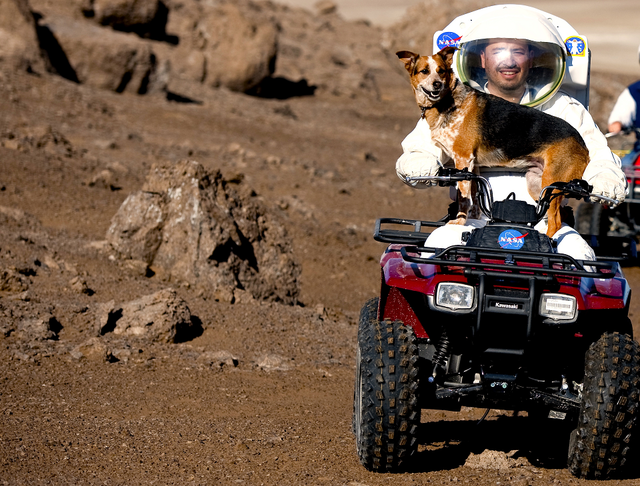Spotlight on Science Writers: Pascal Lee
“...I wanted to inspire and encourage [readers] to enjoy science and dream big. That’s what my old moon books did for me.”
When I was growing up, humans were walking on the moon. That was such an amazing thing. It made me want to explore planets. I became a planetary scientist, and now, I enjoy every day of my life learning about planets and helping plan their exploration. This century, humanity will experience an even greater journey than going to the moon: the first human mission to Mars!
What is it about Mars that fascinates us? I think it’s because it looks so much like our own planet, and it might harbor life. That is, alien life. Mars could be the closest planet to Earth where extraterrestrial life forms might be found. We’re not expecting little green men, but microbes. We don’t know if Mars has any alien life yet, but as a future Mars explorer, you could help us find out!
My little book, Mission: Mars, is about helping kids become Future Mars Explorers. I wanted to write a book that would serve as a basic training manual for kids interested in space exploration. Above all, I wanted it to inspire and encourage them to enjoy science and dream big. That’s what my old moon books did for me when I was a kid.
Going to Mars will be such an exciting adventure. Astronauts will travel in a spaceship with parts launched by the most powerful rocket ever. The trip will last up to two and a half years. Along the way, they could visit the two mysterious moons of Mars, Phobos and Deimos. Once on Mars, they’d live in a sealed Mars Habitat and drive cool Mars rovers to get around and explore the planet.
But going to Mars won’t be easy. The planet is far away, and surface conditions are nothing short of deadly. We’ll need to wear a spacesuit at all times when outside. Mission: Mars tells kids more about this and other things to get them ready for the great journey. So let’s all buckle up for the ride!
About the Author
Dr. Pascal Lee is chairman of the Mars Institute and a planetary scientist at the SETI Institute. He is also director of the NASA Haughton-Mars Project at NASA Ames Research Center. The project helps plan future human missions to Mars.
Pascal’s interest in space began at an early age. When he was six, he built his first “spaceship” by putting a laundry basket on roller skates. Early test flights, often co-piloted with his younger brother, did not always end well. He refined his skills by studying physics and geology at the University of Paris in France. He continued earning a Ph.D. in astronomy and space sciences at Cornell University in New York.
When not researching ways to advance space exploration, Pascal likes to play with his three dogs and paint space art. He is also a helicopter pilot and flight instructor.
His book, Mission: Mars, was the winner for the 2015 AAAS/Subaru SB&F Prize for Excellence in Science Books in the Middle Grades Science Book category.
GOING FURTHER
Book/Author Resources
Pascal Lee's website includes some of his drawings and paintings.
Scholastic's page for Mission: Mars includes videos from Pascal on a variety of Mars-related topics (including whether there are aliens on Mars).
Science Netlinks’ lesson to accompany the book asks students to consider and understand the type of planning involved in designing a mission to another planet.
Mars
Journey to Mars is NASA's website for human travel to and exploration of Mars.
Mars Institute is an international, non-governmental, non-profit research organization dedicated to advancing the scientific study, exploration, and public understanding of Mars.
Mars for Students includes a challenge for students to create a livable Martian community, images from the planet, and paper models to build some of Mars' rovers.
Mars 2020 Perseverance Updates: Photos, Links, and Resources has even more resources about astronomy, engineering, and space exploration relating to NASA's Mars Curiosity rover.
Our Solar System
In this Planet Size Comparison animation, you can find out the dimensions for each planet as well as how they compare in size.
The Planets App provides several different ways for you to get information about objects in the sky.
In the Images of Our Solar System video, artist Michael Benson and planetary scientist Dr. Nancy Chabot discuss the intersection of art and science at the opening of the Planetfall art exhibition.
Elsewhere in Space
GoSkyWatch Planetarium App allows you to identify and locate stars, planets, constellations, and more by touching the screen or by pointing to the sky.
In this video, a panel of scientists working in space science and on space missions describe their careers, talk about how they became space scientists, and offer advice to middle-school students in the audience.
National Optical Astronomy Observatory is the national research and development center for ground-based night-time astronomy.
NASA's Kids' Club provides an abundance of information, images, and interesting things to do on astronomy and the space sciences.


